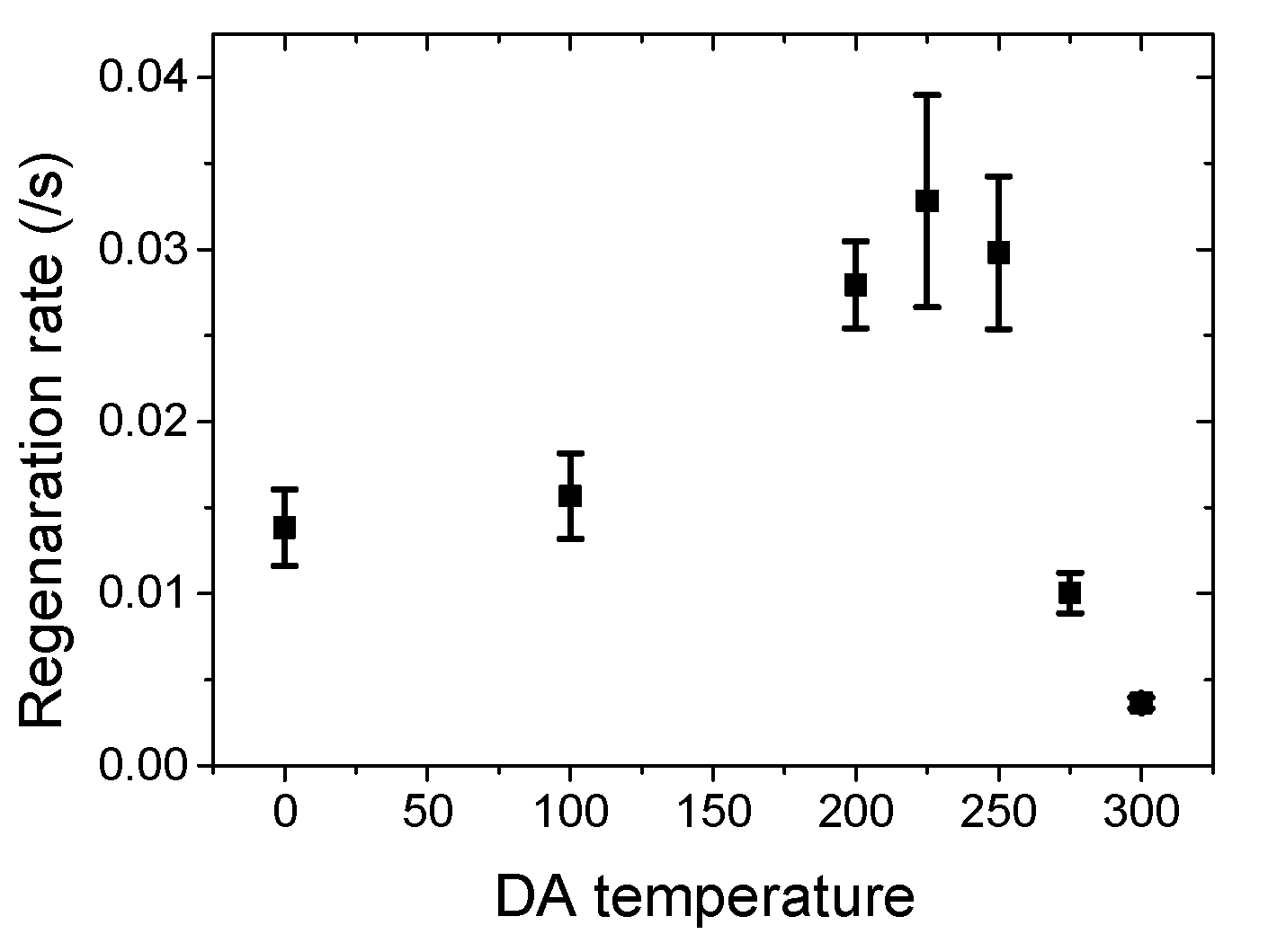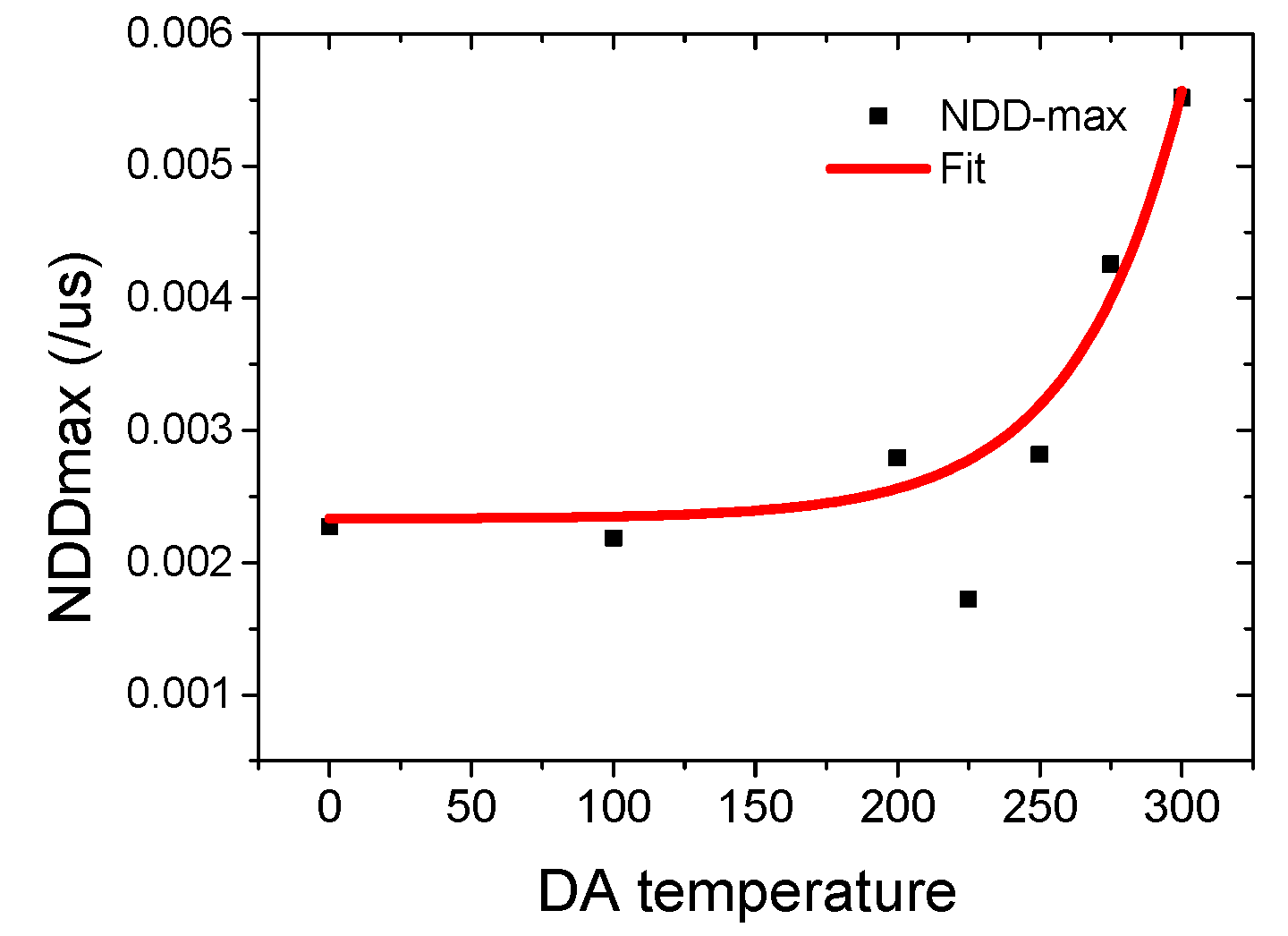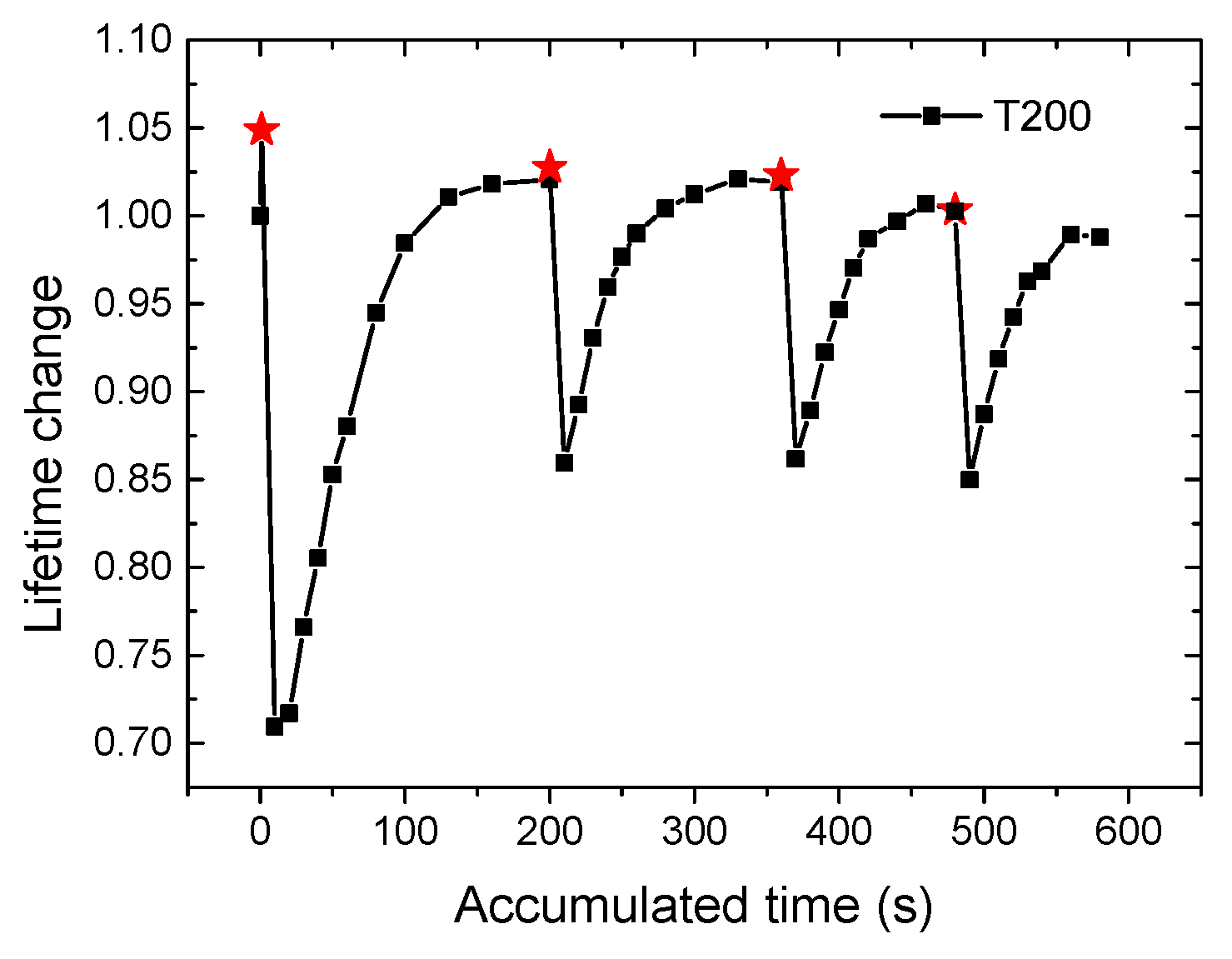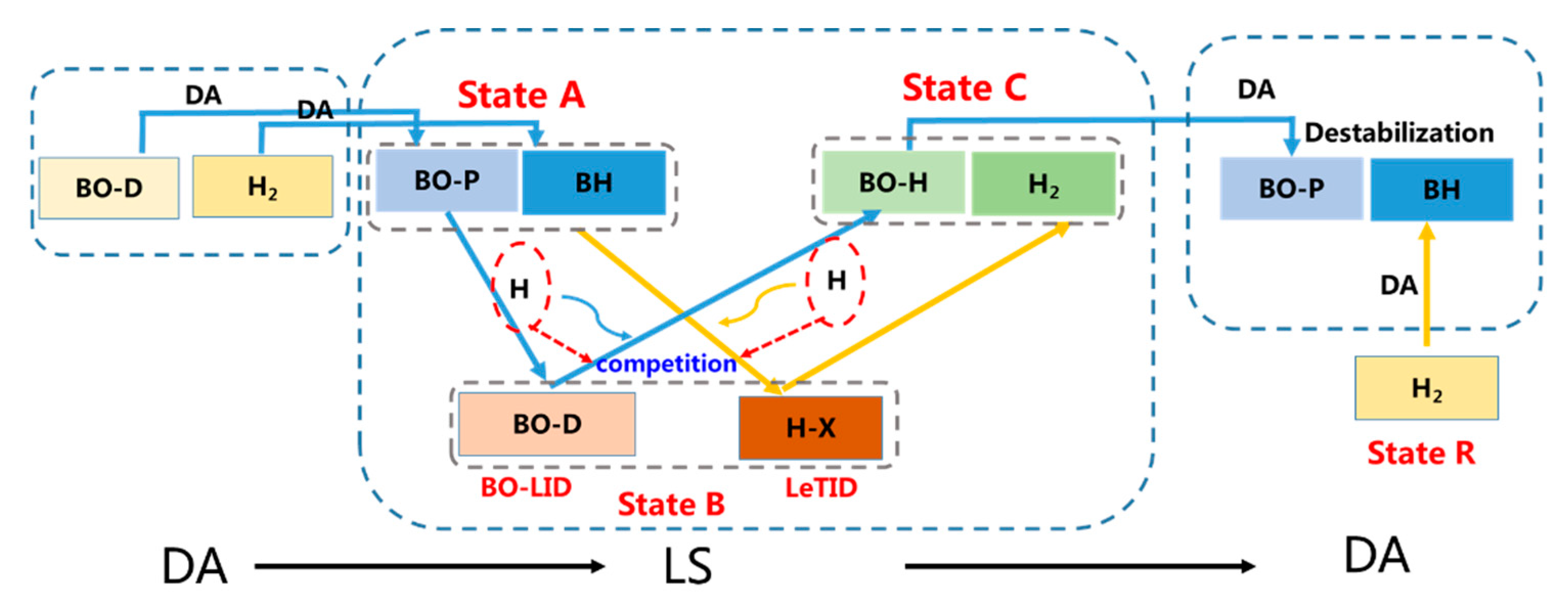Study on the Relationship between BO–LID and LeTID in Czochralski-Grown Monocrystalline Silicon
Abstract
:1. Introduction
2. Experimental Procedure
3. Degradation and Regeneration Kinetics of Monocrystalline Silicon
3.1. LS and DA–LS Experiments at Different LS Temperatures
3.2. LS and DA–LS Experiments at Different LS Irradiation Intensities
3.3. DA–LS Cycling Experiments
4. Analysis
4.1. k-Values of Shockley-Read-Hall (SRH) Defects in Monocrystalline Silicon
4.2. The Relationship between BO–LID and LeTID in Cz-Si
5. Conclusions
- (1)
- It was found in our experiments that the kinetics of Cz-Si can be summarized as follows: The maximum degradation amplitudes depended little on the irradiation intensity, regardless of whether there was a dark annealing treatment. Moreover, the maximum amplitudes were modulated by the DA temperature and were highest at a DA temperature of 300 °C. The regeneration rate was also modulated by the DA temperature and showed a dependence on the BH pair concentration. Most of these behaviors can be explained by BO–LID.
- (2)
- In the DA–LS experiments, it was found that as the number of DA–LS cycles increased, the maximum degradation amplitude changed little from the second cycle for Cz-Si.
- (3)
- By extracting the k-values, it was found that those from the monocrystalline silicon in the degradation state were in the range from 19 to 25. In the DA–LS experiments, the k-values decreased with an increase in the cycling number up to ~10.
- (4)
- Possible reactions and interactions in Cz-Si during DA–LS cycling were analyzed. During LS, interstitial H participated in the passivation of BO defects and the formation of LeTID defects at the same time, resulting in competition between the two reactions. H seemed to prefer to passivate BO defects, and the formation of LeTID seemed to be modulated by the BO concentration.
- (5)
- Moreover, the firing temperature, LS temperature and light intensity, DA temperature, and duration can all affect the behaviors of degradation and regeneration. The diffusion of H in bulk silicon is especially complex [34]. More experiments are needed to further clarify the relationship between BO–LID and LeTID.
Author Contributions
Funding
Conflicts of Interest
References
- Brett, H.; Moonyong, K.; Malcolm, A.; Nitin, N.; Bruno, S.; Stuart, W. Recent insights into boron-oxygen related degradation: Evidence of a single defect. Sol. Energy Mater. Sol. Cells 2017, 173, 25–32. [Google Scholar]
- GlaSer, M.; Lausch, D. Towards a Quantitative Model for BO Regeneration by Means of Charge State Control of Hydrogen. Energy Procedia 2015, 77, 592–598. [Google Scholar] [CrossRef]
- Hahn, G.; Wilking, S.; Herguth, A. BO-Related Defects: Overcoming Bulk Lifetime Degradation in Crystalline Si by Regeneration. Solid State Phenom. 2016, 242, 80–89. [Google Scholar] [CrossRef] [Green Version]
- Voronkov, V.; Falster, R. The nature of boron-oxygen lifetime-degrading centres in silicon. Phys. Status Solidi 2016, 13, 712–717. [Google Scholar] [CrossRef]
- Klaus, R.; Sebastian, Z.; Henning, N.; Axel, M.; Yvonne, G.; Bernhard, B.; Albrecht, S. Light induced degradation of rear passivated mc-si solar cells. In Proceedings of the 27th European Photovoltaic Solar Energy Conference and Exhibition, Frankfurt, Germany, 24–28 September 2012; pp. 861–865. [Google Scholar]
- Nakayashiki, K.; Hofstetter, J.; Morishige, A.E.; Li, T.T.A.; Needleman, D.B.; Jensen, M.A.; Buonassisi, T. Engineering Solutions and Root-Cause Analysis for Light-Induced Degradation in p-Type Multicrystalline Silicon PERC Modules. IEEE J. Photovolt. 2016, 6, 860–868. [Google Scholar] [CrossRef]
- Jensen, M.A.; Morishige, A.E.; Hofstetter, J.; Needleman, D.B.; Buonassisi, T. Evolution of LeTID Defects in p-Type Multicrystalline Silicon During Degradation and Regeneration. IEEE J. Photovolt. 2017, 7, 980–987. [Google Scholar] [CrossRef]
- Zuschlag, A.; Skorka, D.; Hahn, G. Degradation and regeneration analysis in mc-Si. In Proceedings of the Photovoltaic Specialists Conference, Portland, OR, USA, 5–10 June 2016. [Google Scholar]
- Kersten, F.; Engelhart, P.; Ploigt, H.C.; Stekolnikov, A.; Lindner, T.; Stenzel, F.; Bartzsch, M.; Szpeth, A.; Kai, P.; Heitmann, J. Degradation of multicrystalline silicon solar cells and modules after illumination at elevated temperature. Sol. Energy Mater. Sol. Cells 2015, 142, 83–86. [Google Scholar] [CrossRef]
- Chan, C.; Fung, T.H.; Abbott, M.; Payne, D.; Wenham, A.; Hallam, B.; Chen, R.; Wenham, S. Modulation of Carrier-Induced Defect Kinetics in Multi-Crystalline Silicon PERC Cells Through Dark Annealing. Sol. Rrl 2017, 1, 1600028. [Google Scholar] [CrossRef]
- Vargas, C.; Kim, K.; Coletti, G.; Payne, D.; Chan, C.; Wenham, S.; Hameiri, Z. Carrier-Induced Degradation in Multicrystalline Silicon: Dependence on the Silicon Nitride Passivation Layer and Hydrogen Released During Firing. IEEE J. Photovolt. 2018, 8, 413–420. [Google Scholar] [CrossRef]
- Eberle, R.; Kwapil, W.; Schindler, F.; Schubert, M.C.; Glunz, S.W. Impact of the firing temperature profile on light induced degradation of multicrystalline silicon. Phys. Status Solidi Rapid Res. Lett. 2016, 10, 861–865. [Google Scholar] [CrossRef]
- Fung, T.H.; Kim, M.; Chen, D.; Samadi, A.; Chan, C.E.; Hallam, B.J.; Wenham, S.; Abbott, M. Influence of Bound Hydrogen States on Carrier-induced Degradation in Multi-crystalline Silicon. In Proceedings of the 8th International Conference on Crystalline Silicon Photovoltaics, Lausanne, Switzerland, 19–21 March 2018. [Google Scholar]
- Kwapil, W.; Niewelt, T.; Schuberta, M.C. Kinetics of carrier-induced degradation at elevated temperature in multicrystalline silicon solar cells. Energy Procedia 2016, 92, 773–778. [Google Scholar] [CrossRef]
- Schmidt, J.; Bredemeier, D.; Walter, D.C. On the Defect Physics Behind Light and Elevated Temperature-Induced Degradation (LeTID) of Multicrystalline Silicon Solar Cells. IEEE J. Photovolt. 2019, 9, 1497–1503. [Google Scholar] [CrossRef]
- Fung, T.H.; Kim, M.; Chen, D.; Chan, C.E.; Hallam, B.J.; Chen, R.; Payne, D.N.R.; Ciesla, A.; Wenham, S.R.; Abbott, M.D. A four-state kinetic model for the carrier-induced degradation in multicrystalline silicon: Introducing the reservoir state. Sol. Energy Mater. Sol. Cells 2018, 184, 48–56. [Google Scholar] [CrossRef]
- Herguth, A.; Hallam, B. A Generalized Model for Boron-Oxygen Related Light-Induced Degradation in Crystalline Silicon. In Proceedings of the 8th International Conference on Crystalline Silicon Photovoltaics, Lausanne, Switzerland, 19–21 March 2018. [Google Scholar]
- Herguth, A.; Schubert, G.; Kaes, M.; Hahn, G. A New Approach to Prevent the Negative Impact of the Metastable Defect in Boron Doped CZ Silicon Solar Cells. In Proceedings of the IEEE World Conference on Photovoltaic Energy Conversion, Waikoloa, HI, USA, 7–12 May 2006. [Google Scholar]
- Fertig, F.; Lantzsch, R.; Mohr, A.; Schaper, M.; Bartzsch, M.; Wissen, D.; Kersten, F.; Mette, A.; Peters, S.; Eidner, A.; et al. Mass production of p-type Cz silicon solar cells approaching average stable conversion efficiencies of 22%. Energy Procedia 2017, 124, 338–345. [Google Scholar] [CrossRef]
- Nampalli, N.; Li, H.; Kim, M.; Stefani, B.; Wenham, S.; Hallam, B.; Abbott, M. Multiple pathways for permanent deactivation of boron-oxygen defects in p-type silicon. Sol. Energy Mater. Sol. Cells 2017, 173, 12–17. [Google Scholar] [CrossRef]
- Chen, D.; Kim, M.; Stefani, B.V.; Hallam, B.J.; Abbott, M.D.; Chan, C.E.; Chen, R.; Payne, D.N.R.; Nampalli, N.; Ciesla, A. Evidence of an identical firing-activated carrier-induced defect in monocrystalline and multicrystalline silicon. Sol. Energy Mater. Sol. Cells 2017, 172, 293–300. [Google Scholar] [CrossRef]
- Winter, M.; Walter, D.; Bredemeier, D.; Schmidt, J. Light-induced lifetime degradation effects at elevated temperature in Czochralski-grown silicon beyond boron-oxygen-related degradation. Sol. Energy Mater. Sol. Cells 2019, 201, 110060. [Google Scholar] [CrossRef]
- Knobloch, J.; Glunz, S.W.; Biro, D.; Warta, W.; Schaffer, E.; Wettling, W. Solar cells with efficiencies above 21% processed from Czochralski grown silicon. In Proceedings of the IEEE Photovoltaic Specialists Conference, Washington, DC, USA, 13–17 May 1996. [Google Scholar]
- Wenham, A.C.N.; Wenham, S.; Chen, R.; Chan, C.; Chen, D.; Hallam, B.; Payne, D.; Fung, T.; Kim, M. Hydrogen-Induced Degradation. In Proceedings of the 7th World Conference on Photovoltaic Energy Conversion, Waikoloa Village, HI, USA, 10–15 June 2018; pp. 1–8. [Google Scholar]
- Murphy, J.D.; Bothe, K.; Krain, R.; Voronkov, V.V.; Falster, R.J. Parameterisation of injection-dependent lifetime measurements in semiconductors in terms of Shockley-Read-Hall statistics: An application to oxide precipitates in silicon. J. Appl. Phys. 2012, 111, 113709. [Google Scholar] [CrossRef] [Green Version]
- Voronkov, V.V.; Falster, R.; Bothe, K.; Lim, B.; Schmidt, J. Lifetime-degrading boron-oxygen centres in p-type and n-type compensated silicon. J. Appl. Phys. 2011, 110, 404. [Google Scholar] [CrossRef]
- Morishige, A.E.; Jensen, M.A.; Needleman, D.B.; Nakayashiki, K.; Buonassisi, T. Lifetime spectroscopy investigation of light-induced degradation in p-type multicrystalline silicon PERC. IEEE J. Photovolt. 2016, 6, 1466–1472. [Google Scholar] [CrossRef]
- Sperber, D.; Herguth, A.; Hahn, G. A 3-state defect model for light-induced degradation in boron-doped float-zone silicon. Phys. Status Solidi RRL Rapid Res. Lett. 2017, 11, 1600408. [Google Scholar] [CrossRef] [Green Version]
- Voronkov, V.V.; Falster, R. Formation, dissociation, and diffusion of various hydrogen dimers in silicon. Phys. Status Solidi 2017, 254, 1600779. [Google Scholar] [CrossRef]
- Bothe, K.; Schmidt, J. Fast-forming boron-oxygen-related recombination center in crystalline silicon. Appl. Phys. Lett. 2005, 87, 262108. [Google Scholar] [CrossRef]
- Niewelt, T.; Schön, J.; Warta, W.; Glunz, S.W.; Schubert, M.C. Degradation of Crystalline Silicon Due to Boron–Oxygen Defects. IEEE J. Photovolt. 2016, 7, 383–398. [Google Scholar] [CrossRef]
- Zundel, T.; Weber, J. Boron reactivation kinetics in hydrogenated silicon after annealing in the dark or under illumination. Phys. Rev. B Condens. Matter 1991, 43, 4361–4372. [Google Scholar] [CrossRef] [PubMed]
- Seager, C.H.; Anderson, R.A. Two-step debonding of hydrogen from boron acceptors in silicon. Appl. Phys. Lett. 1991, 59, 585–587. [Google Scholar] [CrossRef]
- Sheoran, M.; Kim, D.S.; Rohatgi, A.; Dekkers, H.F.W. Hydrogen diffusion in silicon from plasma-enhanced chemical vapor deposited silicon nitride film at high temperature. Appl. Phys. Lett. 2008, 92, 931. [Google Scholar] [CrossRef]










| Number of Cycles | 200DA | 300DA |
|---|---|---|
| First cycle | 19.54 | 20.52 |
| Second cycle | 17.52 | 14.48 |
| Third cycle | 16.54 | 10.87 |
| Forth cycle | 15.98 | 10.78 |
Publisher’s Note: MDPI stays neutral with regard to jurisdictional claims in published maps and institutional affiliations. |
© 2020 by the authors. Licensee MDPI, Basel, Switzerland. This article is an open access article distributed under the terms and conditions of the Creative Commons Attribution (CC BY) license (http://creativecommons.org/licenses/by/4.0/).
Share and Cite
Li, H.; Wang, X.; Lv, F.; Wang, Y.; Cheng, S.; Zhou, C.; Wang, W. Study on the Relationship between BO–LID and LeTID in Czochralski-Grown Monocrystalline Silicon. Energies 2020, 13, 5961. https://doi.org/10.3390/en13225961
Li H, Wang X, Lv F, Wang Y, Cheng S, Zhou C, Wang W. Study on the Relationship between BO–LID and LeTID in Czochralski-Grown Monocrystalline Silicon. Energies. 2020; 13(22):5961. https://doi.org/10.3390/en13225961
Chicago/Turabian StyleLi, Hailing, Xinxin Wang, Fang Lv, Yibo Wang, Shangzhi Cheng, Chunlan Zhou, and Wenjing Wang. 2020. "Study on the Relationship between BO–LID and LeTID in Czochralski-Grown Monocrystalline Silicon" Energies 13, no. 22: 5961. https://doi.org/10.3390/en13225961





